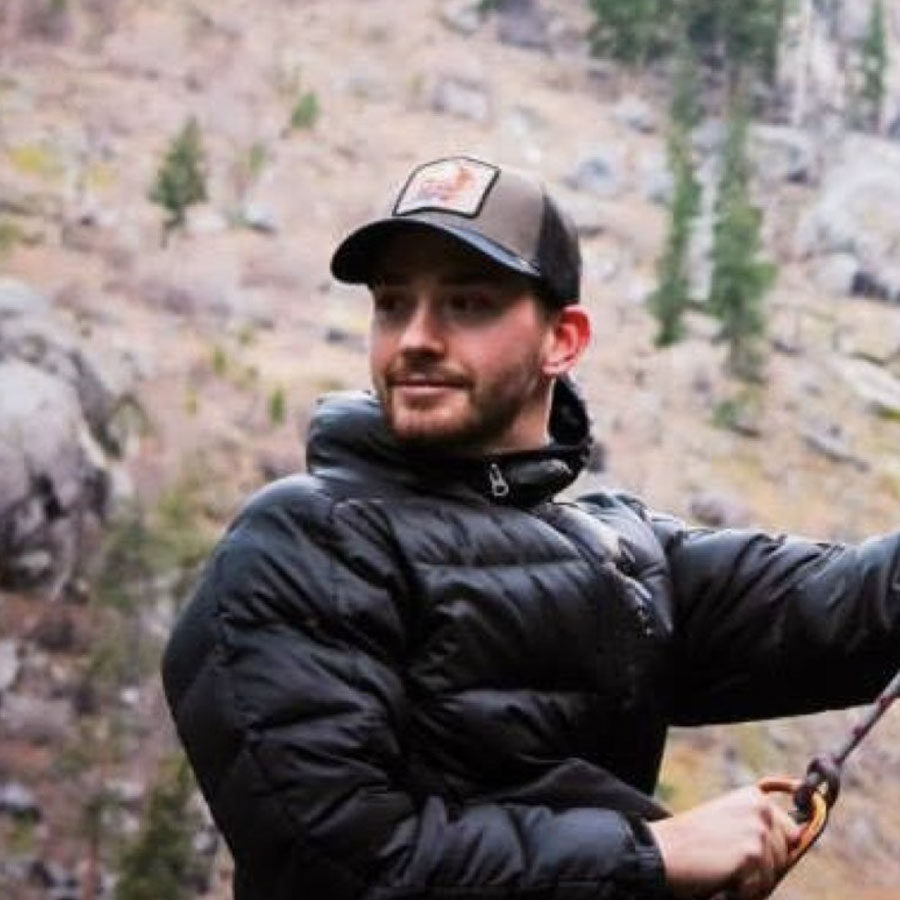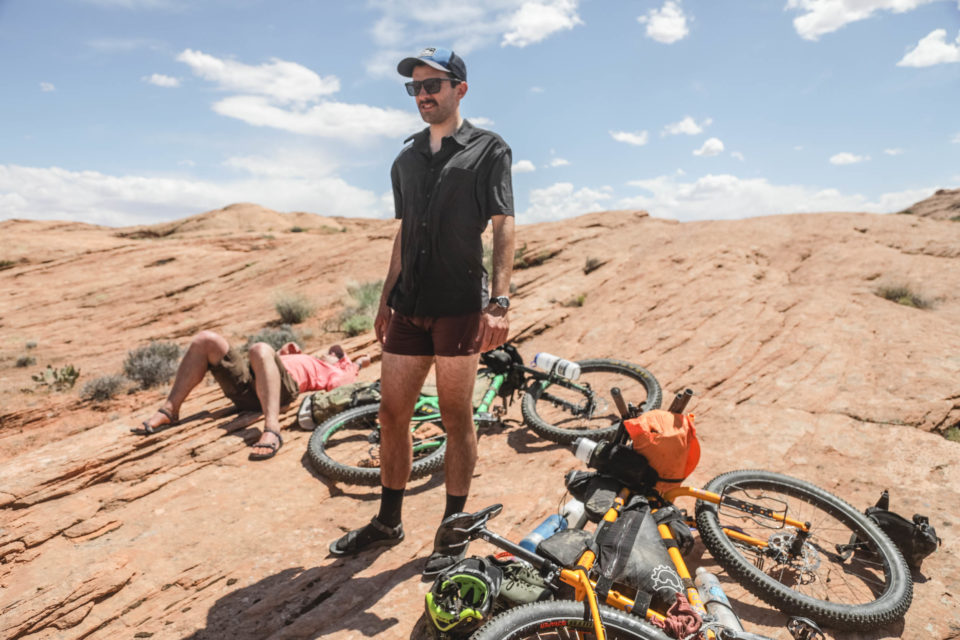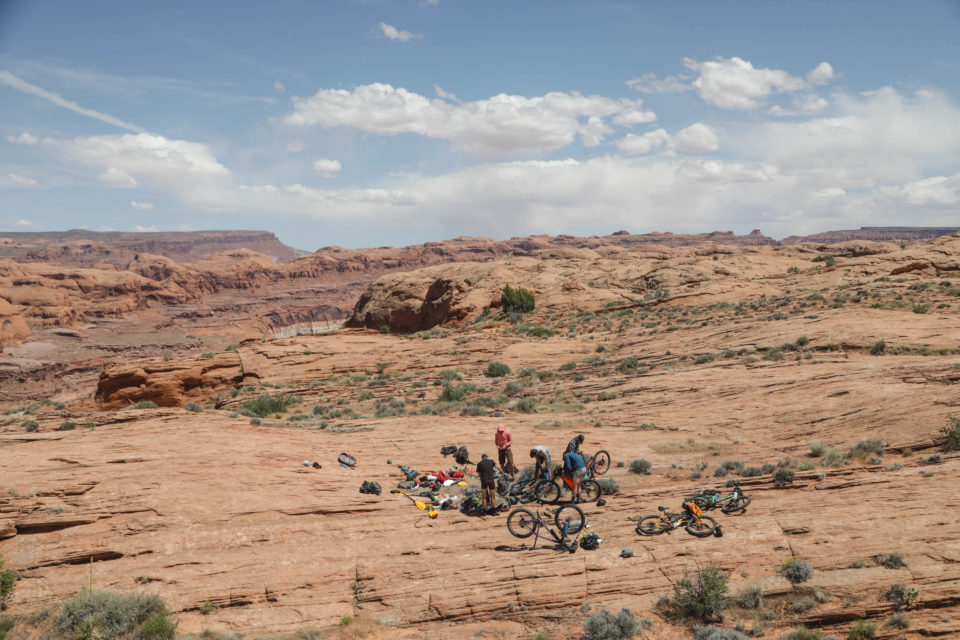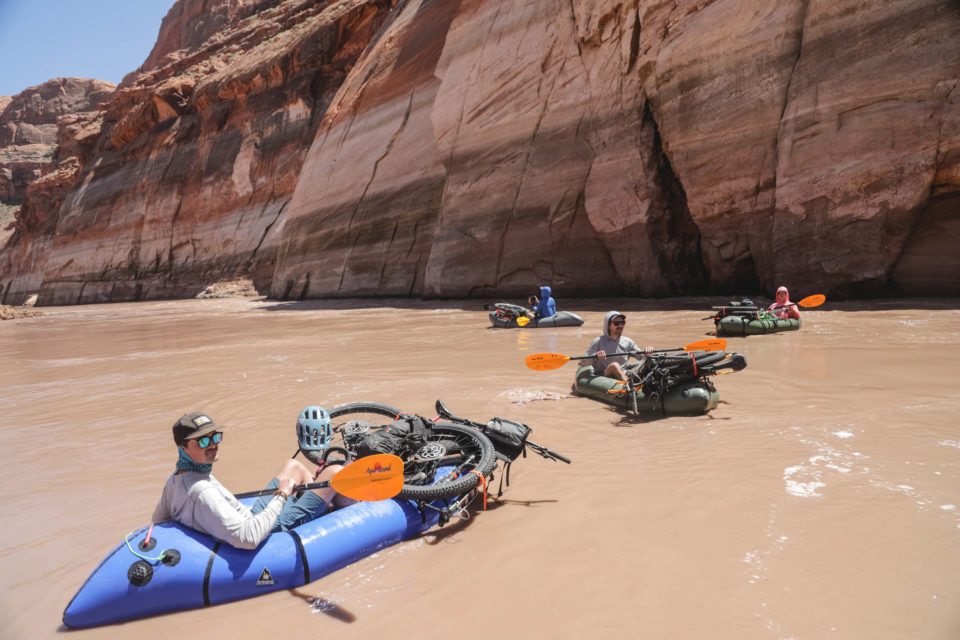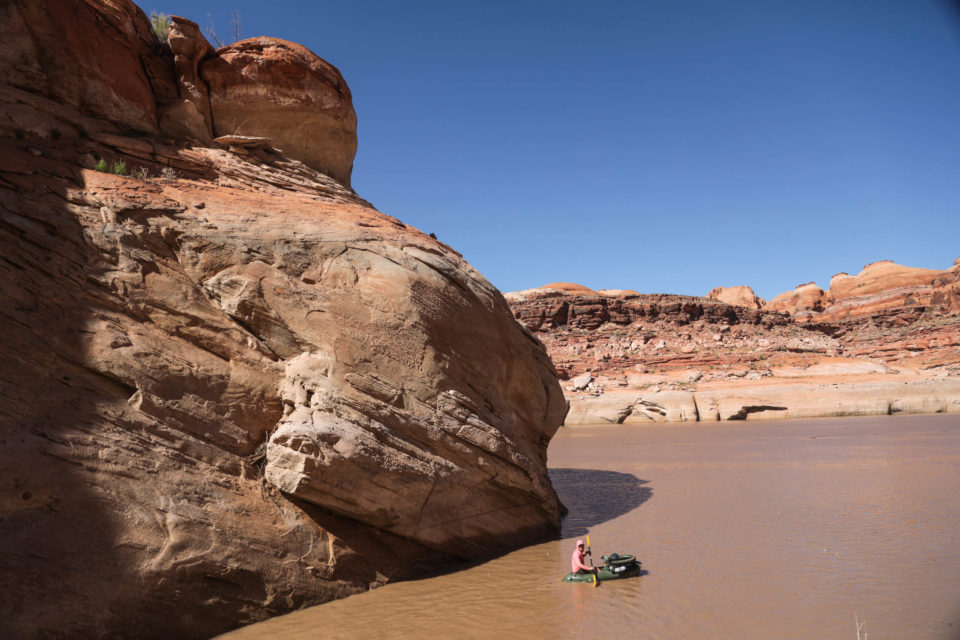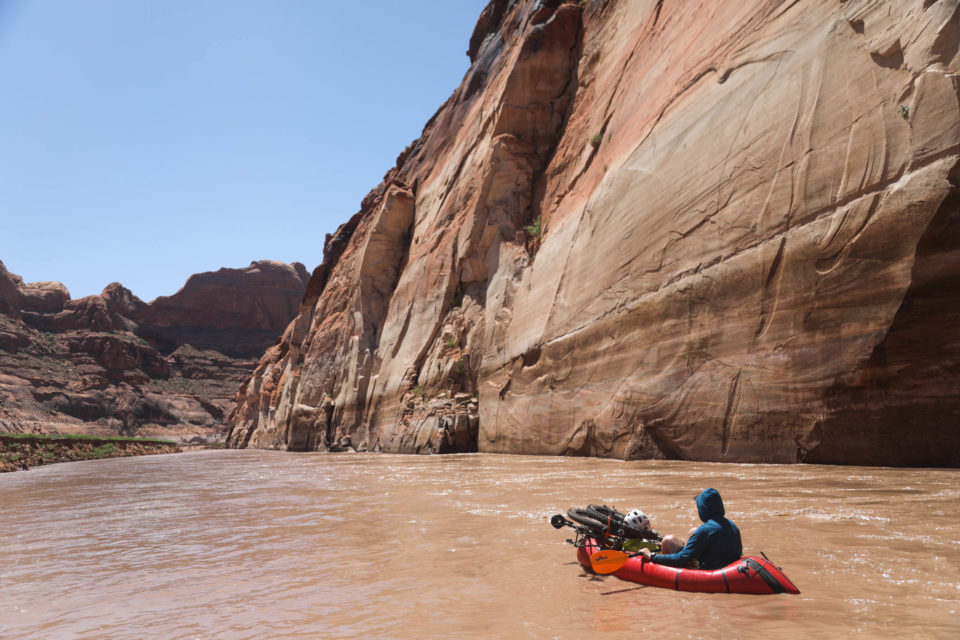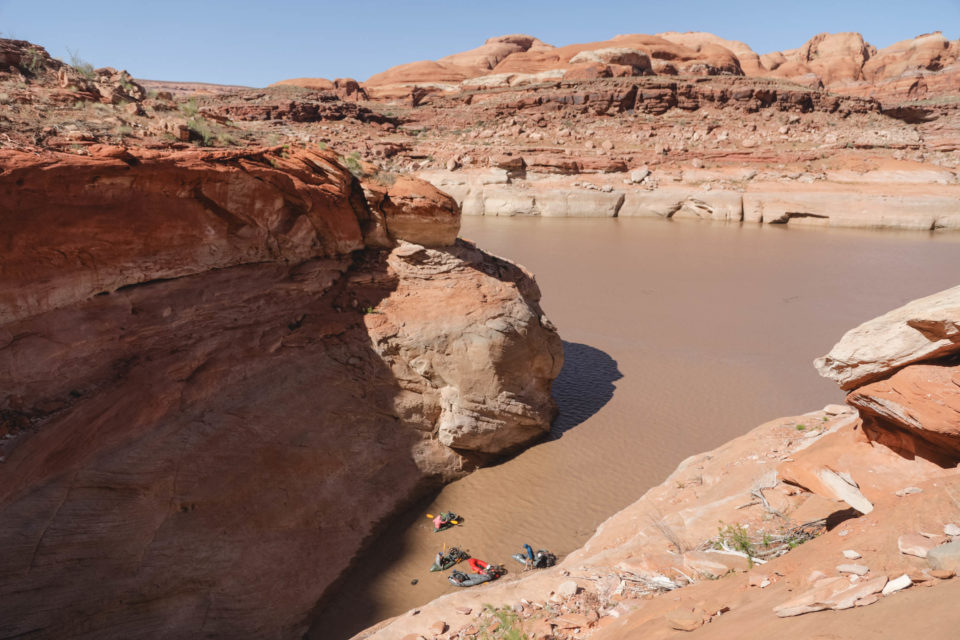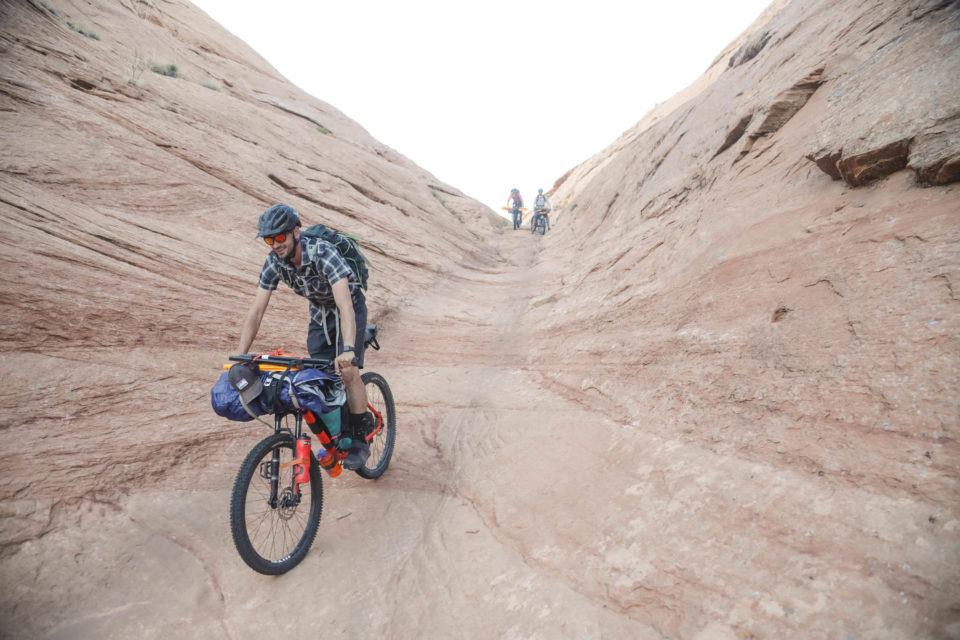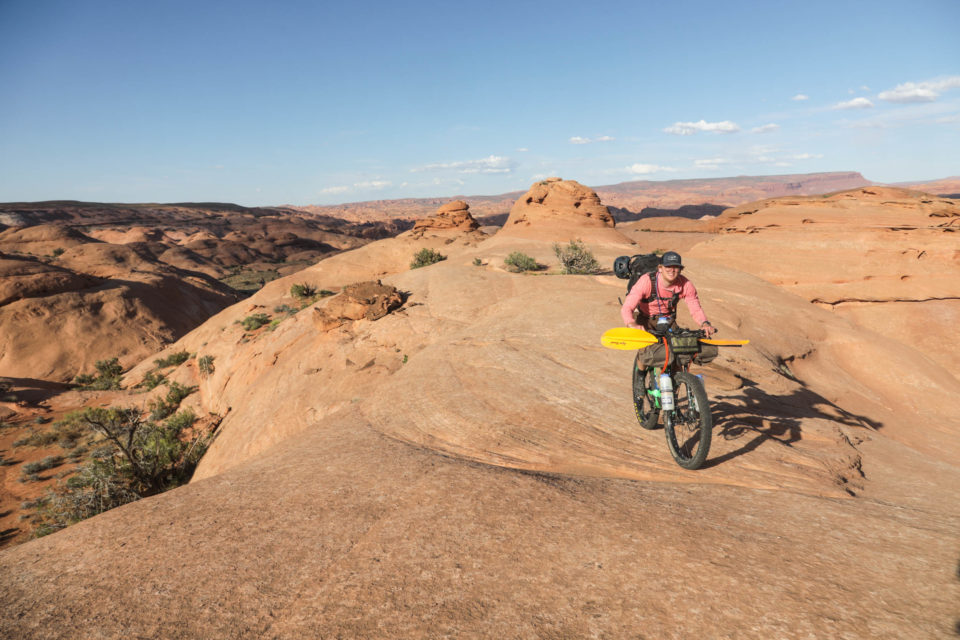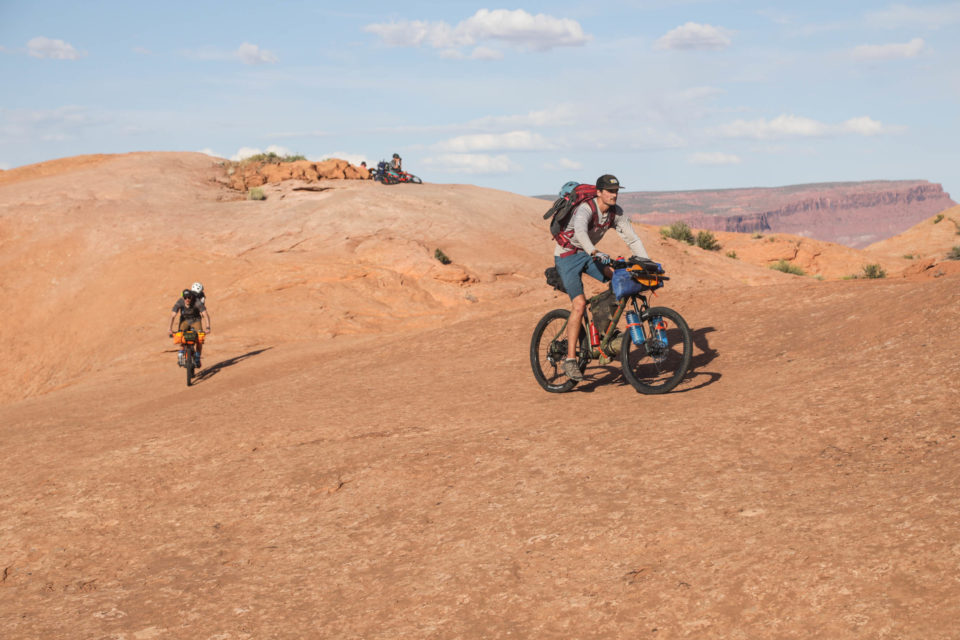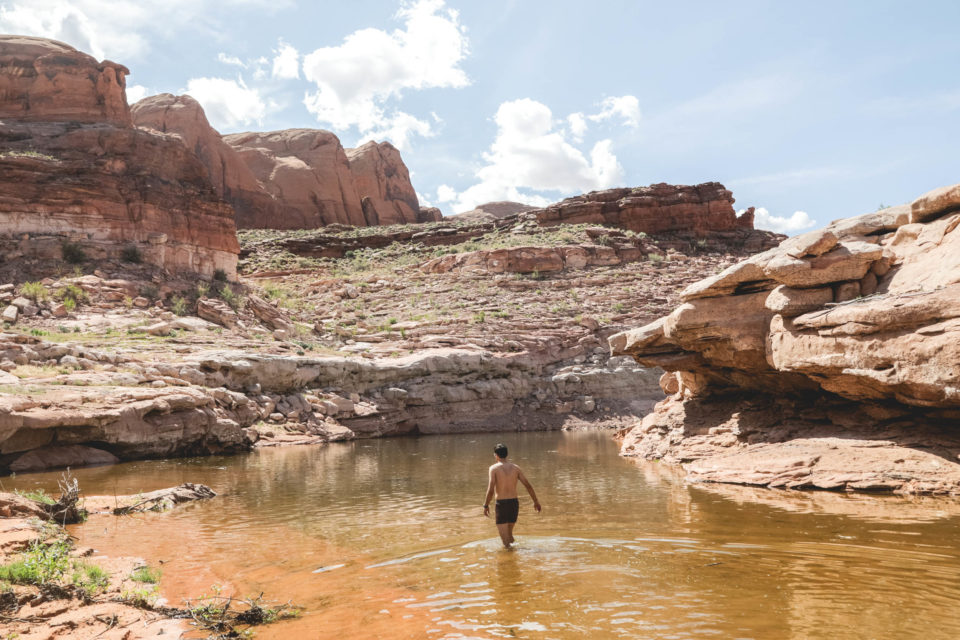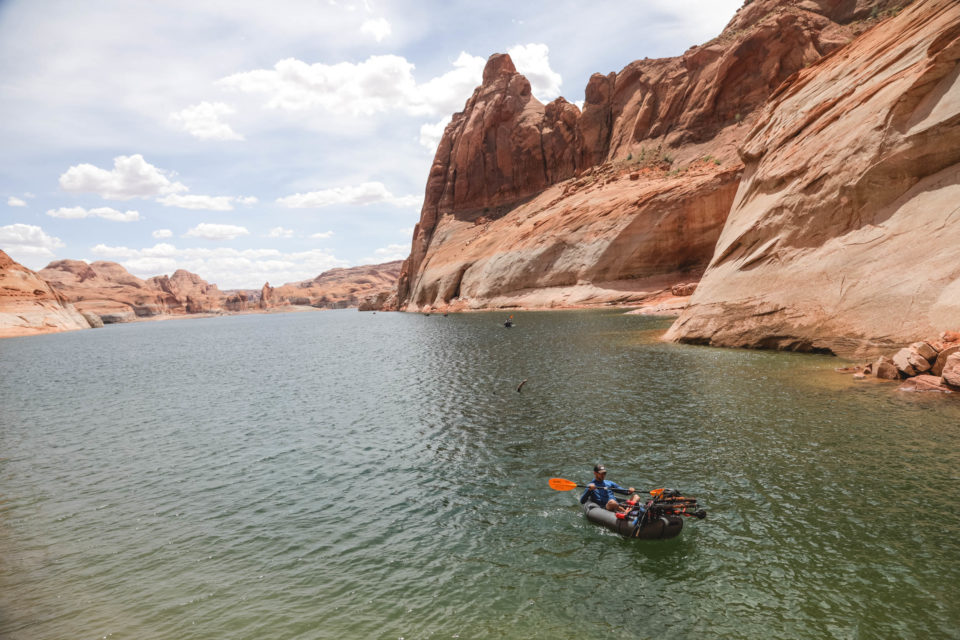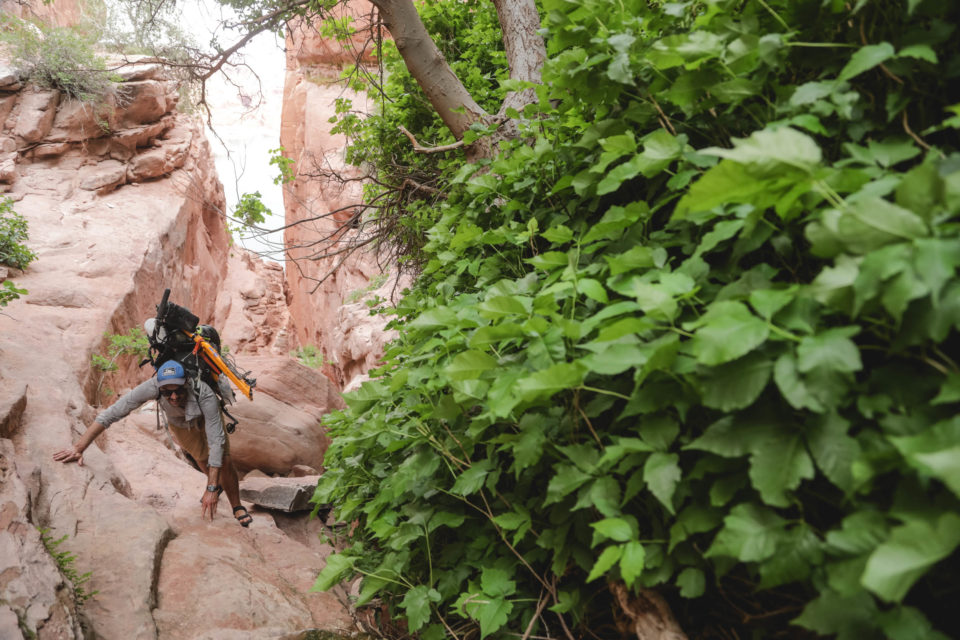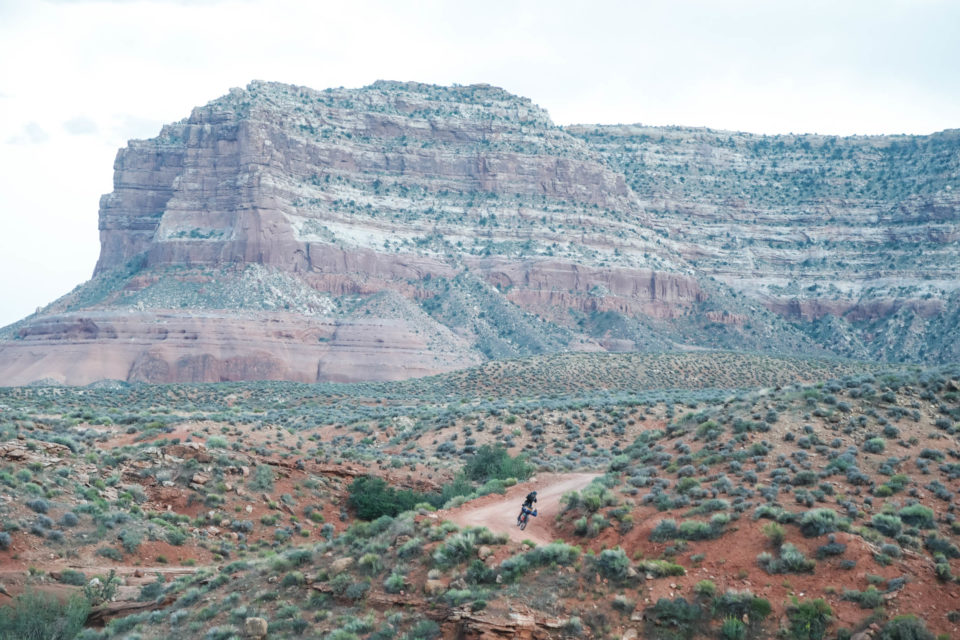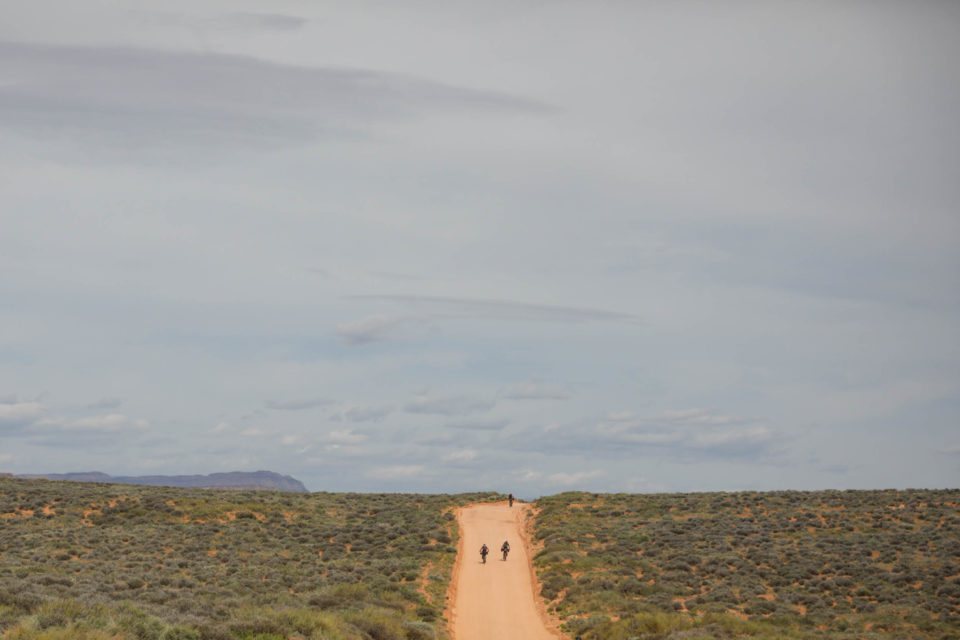Sandbagged: Escalante Bikerafting
Share This
Following a loose description of a possible route, Colt Fetters and friends headed to Utah for a bikepacking and packrafting trip along the San Juan River and into Lake Powell. Find their story of navigating rapids, avoiding waterfalls, rolling through otherworldly landscapes, and carrying their bikes up cliffs here…
Following beta from some of the most adventurous bikepackers in the country is likely to leave you thirsty, tired, and unsure about the feasibility of success. In short, trusting beta from the likes of a man who goes by “Doom” surely can’t be a good idea.
We scrambled on sandstone slabs as we looked out over the San Juan River and our camp, some 500 feet below. Bikes strapped awkwardly to our backs, we navigated 5th class slabs to the top of the mesa. It took eight trips between six team members before all of our bikes, packrafts, and equipment had been hauled to the top. All said and done, from the river to the top of the canyon, it took us eight hours to get everything up.
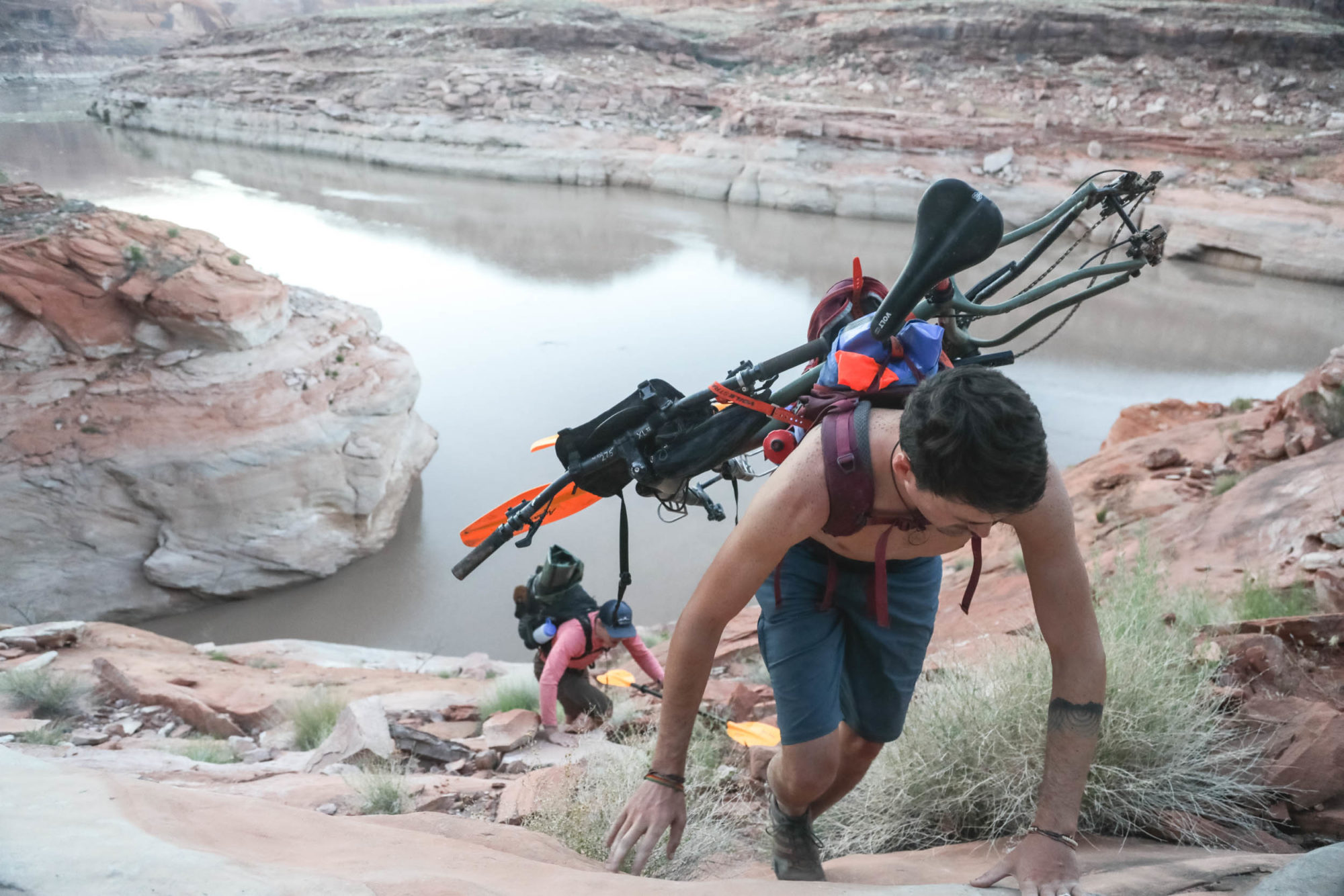
Escalante is rough country, but we at least had peace of mind in knowing this route had been travelled before, and by two of the best. Brett Davis and Steve “Doom” Fassbinder are notable figures in the niche world of bikerafting, and their expeditions through the Wrangell St. Elias range, the Lost Coast, and Tajikistan are some of the most adventurous bikepacking trips I’ve heard or read about in the last decade. If there’s anything I know about these two, it’s that they tend to understate hardships, whether handing out beta to “young guns” or sharing tales about their own epics. For instance: sitting in a tent for days without food in the high mountains of the Wrangells, waiting out a winter storm. It’s the subtle art of sandbagging. Tempting other younger bikepackers with, “Oh, it’s not that bad,” or “You’ve totally got it.” So, when picking their brains about this route and hearing them describe it as “ totally doable” with the caveat “but it’s not going to be easy,” I started to worry.
There were six of us in our group, two Washingtonians and four boys from Alabama. Friends made from years in college, racing bikes, and drinking copious amounts of southern craft beer. There we were in the middle of the southern Utah desert, one of the most remote regions in the continental U.S. There was a wide array of skill sets and abilities among the Alabama boys. Some had never paddled their own watercraft before, others had never bikepacked, and others had never had to navigate technical rock climbs, especially un-roped.

Our first morning, we inflated our boats and pushed off into the current, past the giant “Danger Ahead” sign that warned rafters that our put-in was the very last take-out before an unnavigable waterfall and harsh country ahead. We had set off, and there was no way of turning around as the current guided us into the canyon ahead.
Soon after came the rapids. With no PFDs (life jackets), there was no room for error. Small as the rapids were, they still held the consequence of dumping us, our gear, and our poorly lashed bikes into the river. We carried only what we needed, so anything we lost could have serious consequences. As we rounded a bend, the unmistakable roar of the waterfall was clear. I’d heard talk of the large and violent feature, and the keeper hole at the bottom that could surely drown a swimmer who wasn’t wearing a PFD. An eddy just 20 feet above the falls was our key to making it safely around. One by one, we all snuck into the eddy and jumped ashore, hauling our bicycle-laden boats up the beach before the current could pull us down into the massive waterfall below. Hauling our rigs around the falls to the pool below, we felt victorious about having navigated the first piece of the puzzle in our multi-sport traverse.
Calm waters ushered us past striking sandstone walls and lush green canyons until the flow slowed to a stop. We had reached Lake Powell, where the turbid, sandy water of the San Juan meets the calm blue waters of the manmade reservoir. This is where the shady adventurer known as Doom told us we may be able to find a way out of the river. Lake levels have changed dramatically over the years, and seasons of drought and ever-increasing water needs in places like Las Vegas have drained Lake Powell to 40% of its capacity. Canyons that were tragically drowned by the Glen Canyon Dam were seeing the light of day for the first time in a decade. A simple photo of a map was our only clue as to how Doom managed this exit years before. Around 1,500 feet of broken cliffs towered above us. We studied possible routes from our boats, none of which looked very promising. We decided the only way to know for sure was to start scouting.
A small cove led us to the bike shuttle of a lifetime. For four hours we shuttled gear up to a large vegetated ledge half way up the climb. The sun set, officially designating that ledge our camp for the night. What a place for camp! We were perched 500 feet above the San Juan river without a trace of civilization in sight.
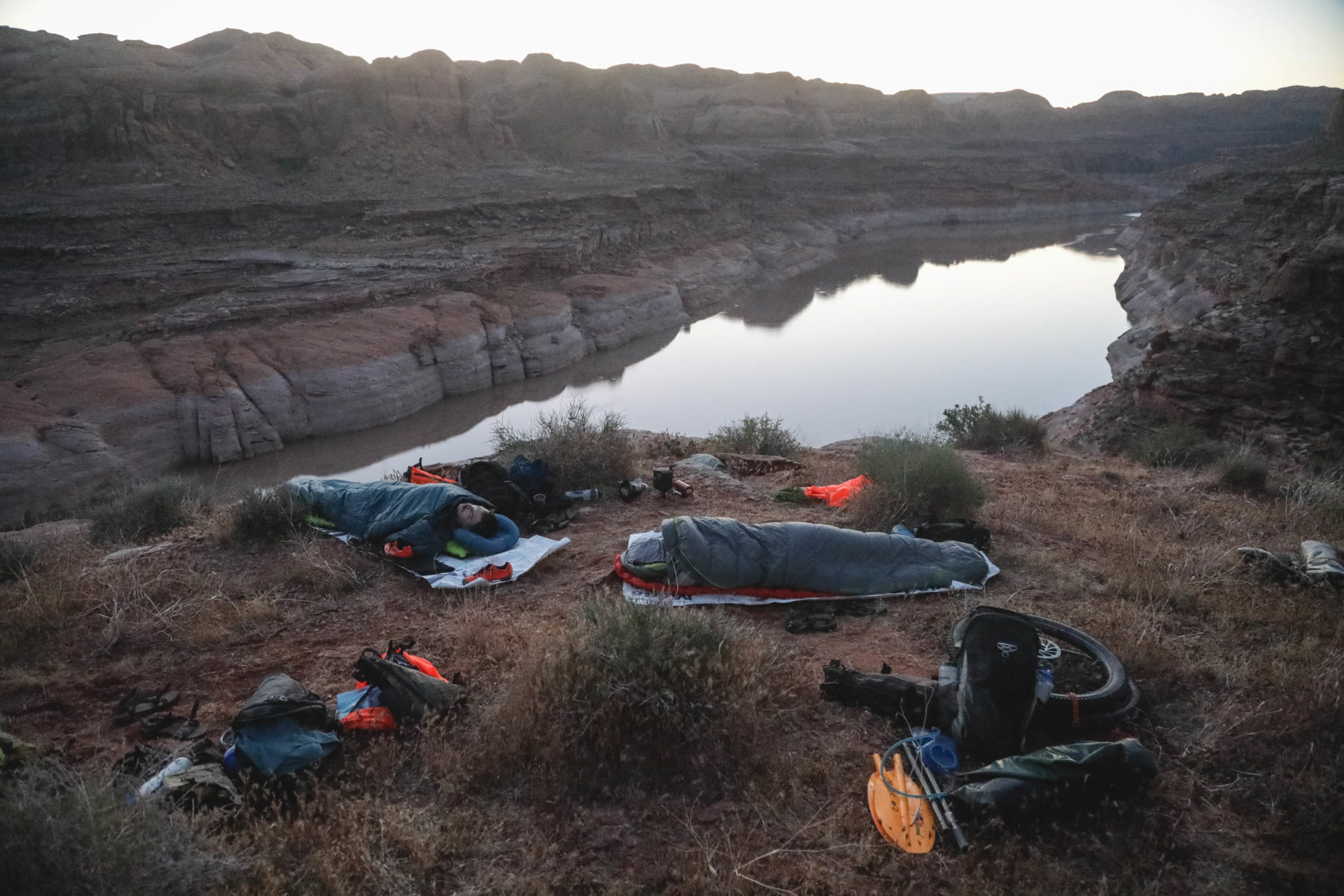
I awoke to a feeling of dread, worried about what the day would bring. Sure, yesterday was tough, but this was the absolute crux of the trip. Above us was another 1,000 feet of complex sandstone slabs, broken by ledges and intricacies that would undoubtedly be difficult to navigate. Two of us had scouted a route the night before, which was possible but was full of incredibly consequential terrain. The Alabama boys were gripped and so were we. In many spots, a slip would surely result in a fatal fall. Could this really be the same route Doom had navigated years ago? It was impossible to tell, given the complex landscape. Yet not a single one among us wanted to climb back down and start all over.
Left with one precarious option, we started up with simple loads, backpacks filled with packrafts and broken-down paddles, the Alabama boys on the easier section and the more competent climbers on the more insecure slabs. We’d unload the packs on top of the mesa and start back down for another load. Bike wheels were next, lashed to packs, and we carefully climbed upwards, trying to avoid being tossed off balance by the awkward load. Then bike frames.
By the time we reached the top with the last load, it was noon and we were nearly out of water. The river, almost 1,500 feet below, wasn’t an option. The San Juan River is full of silt, imparting its muddy brown hues. It flows at about 10 percent sediment per volume, wet concrete for comparison is about 30 percent. Plainly put, the San Juan is not an adequate source of drinking water, so we continued on to the next piece of the puzzle.

The GPS showed us that only one mile stood between us and the dirt road we were aiming for. Between us awaited some of the most complex domelands I’d ever navigated. Even at our slowest, pushing bikes, we could be to the road in just a couple of hours. Or so we thought. The towering sandstone domes were laced with narrow slot canyons. Spanning bridges linked us from one dome to the next. When we could ride, it was some of the most otherworldly biking I’ve ever experienced, not unlike the world famous Slickrock Trail only a couple hundred miles to our northeast. But the difference was that much of what we rode had likely never been ridden before. Even the group that had come before us surely found a route of their own in this complicated country. Time and time again, we’d be squeezed into a dead end and would have to back track, finding our way through this labyrinth.
It’d been nearly a month since Escalante had a proper rain. As a rule of thumb, it’s easy to find water a week after rain on slickrock. After two weeks, you have to find shaded potholes. After four, however, it becomes nearly impossible. The solace of these intricate canyon systems, although difficult to navigate, is that they funnel water. It was mostly by luck that I chose to follow a drainage and discovered deep potholes full of musty water. They were covered with dead flies and desert sediment, but there was enough water for us all to fill our bottles and our bellies.
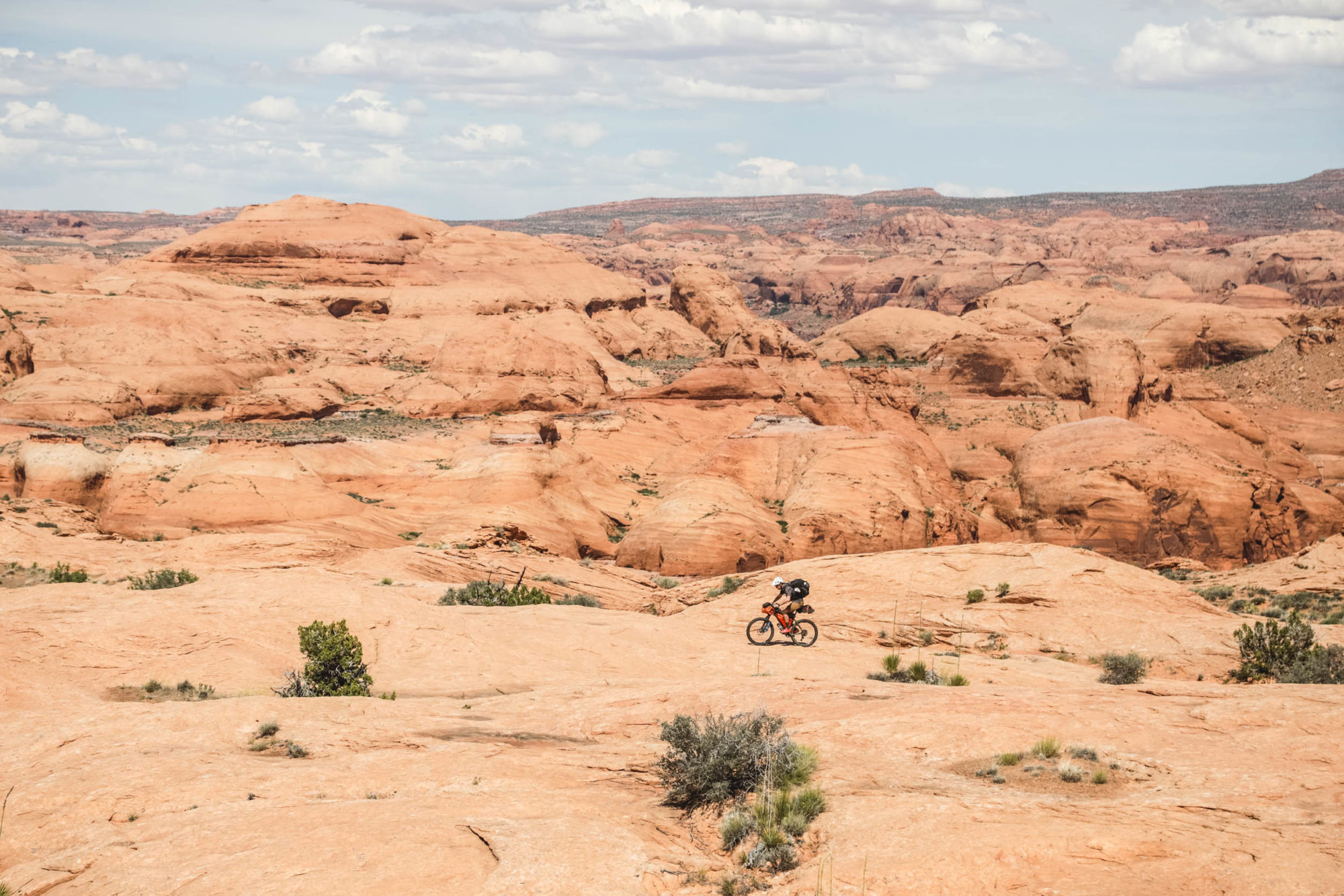
Ultimately, we gained the top of the mesa and were able to spot the road in the distance. By the time we reached the road and found a place to sleep the day was almost over. After nearly 14 hours, we’d travelled maybe five miles, optimistically. It was a stark reminder that mileage and elevation don’t alone dictate pace.
The biggest pieces of the puzzle had been solved. Sure, after nearly half our time allotted, we were only 30 miles into a 200-mile trip, but we were absolutely sure the rest was possible. The boys started to enjoy themselves, loaded up with cold water and freeze dried food. After a morning of simple navigation along the Emigrant Trail, we started dropping into Cottonwood Canyon, a tributary to the mighty Glen Canyon.

Reaching the lake, we inflated our packrafts and again loaded our bikes onto the bows, paddling out of the narrows of the canyon into the open water. I could see why people are so infatuated with Lake Powell, where stark red walls of sandstone stand vertically above clear blue water. A pang of guilt struck me for enjoying it after hearing so many stories about the putrid Lake Foul and how it desecrated one of the greatest canyon systems in existence when it was created by the construction of the Glen Canyon Dam in 1968. The Colorado and San Juan Rivers flooded over 1,000 years of ancient puebloan history. Dwellings, rock art, ceremonial sites, and artifacts all drowned in what many conservationists call the one of the greatest atrocities of the 20th century. Edward Abbey pened an entire essay on the subject, titled The Damnation of a Canyon. As we paddled across the turquoise blue water I could only wonder what mysteries were beneath us and how it would have been to experience the canyon in its natural state.
When we reached shore on the other side we stared up at a large manmade canyon above us. A steep trail led us up 1,000 feet to the canyon rim. This was Hole in the Rock. In 1879, a Mormon mission with 250 men, women, and children set out across the southeastern Utah desert to establish what is now Bluff, Utah. When they came upon Glen Canyon, with the Colorado River way down below, they needed a path down the steep canyon walls for their 83 wagons filled full of provisions for their journey across the desert. Over the course of an entire winter, they blasted the mouth of the canyon rim until a narrow and precarious path was built to accommodate the wagons. In some spots the path is almost 50 degrees in angle, gouges from the wagon axles still visible over 100 years later.

Once again, we strapped our bikes to our backs. One trip with bikes, another with wheels, and the last with packrafts and the rest of our cargo. At the top of Hole in the Rock, we came into contact with other people for the first time in a while. Good ol’ country folk, the kind of people who travel with large coolers strapped to the back of their ATVs. The kind of people who, when they hear what you’ve been up to, can’t help but offer you a cold beer. Every time we clambered to the top with more gear in tow, we were greeted by another group aboard four-wheelers, just as incredulous as the last. And again, they’d offer us beer.
Sunburnt, dirty, and drunk, we sat at the top of Hole in the Rock feeling pretty damn good about ourselves. We still had 80 miles of riding left to the little town of Boulder, Utah, mostly along washboard dirt roads. Thankfully, we’d made it through the worst of it, and there wasn’t anything left to worry about. Our path was simple from there, we just needed to spin the pedals.
This trip ended as most in this digital age do: with an instagram post. Shortly thereafter, a comment popped up. It was Doom. His comment was simple, “Punish Them!!!” Riding back from Boulder in a van with six bikes, six beaten down riders, and one lovely shuttle driver, we sure felt punished.
Please keep the conversation civil, constructive, and inclusive, or your comment will be removed.












